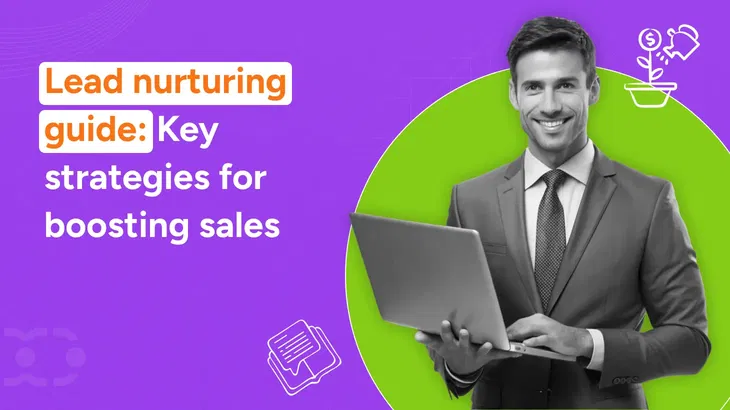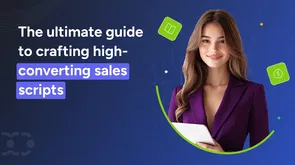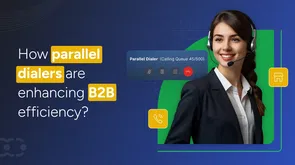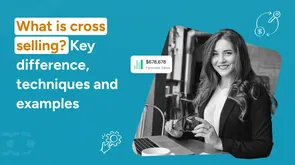Imagine planting a seed and expecting it to grow without water, sunlight, or care. That's what happens when businesses generate leads but fail to nurture them.
79% of marketing leads never turn into sales due to poor lead nurturing.
Meanwhile, companies that master lead nurturing generate 50% more sales-ready leads at 33% lower costs.
This guide will break down the best lead nurturing strategies to help you turn cold prospects into loyal customers.
What is lead nurturing?
Lead nurturing is a structured approach to engaging with your target audience. It involves providing valuable insights that guide them through the sales funnel.
The goal is simple: when they're ready to decide, your brand should be the first thing they think of.
Imagine someone downloading a guide from your website about choosing the right CRM. Instead of immediately pushing for a sale, you send them a follow-up email with a case study showing how a business streamlined its sales process using your CRM. A few days later, they receive a short explainer video, showing how the CRM solves their biggest sales bottlenecks.
B2B sales cycles are longer, involve multiple decision-makers, and require trust-building. Lead nurturing bridges these gaps by:
- Ensuring consistent engagement
- Addressing buyer concerns proactively
- Providing relevant solutions at the right time
Now, let's explore why lead nurturing is particularly crucial for B2B businesses and the benefits it brings.
Why lead nurturing is essential for B2B growth?
Lead nurturing drives higher conversions, accelerates the sales cycle, and improves ROI by engaging prospects at key touchpoints.
Instead of relying on one-time interactions, businesses that nurture leads consistently see greater deal sizes and long-term customer relationships.
Here are the key benefits of lead nurturing efforts:
Data proves that nurturing leads isn’t just about engagement. It also directly drives revenue, shortens sales cycles, and increases deal sizes.
Here’s why it matters:
- Enhanced purchase value: Nurtured leads tend to make 47% larger purchases than non-nurtured leads.
- Increased sales-ready leads: Businesses implementing effective lead nurturing strategies generate 50% more qualified leads while reducing acquisition costs by 33%.
- Shortened sales cycle: Nurtured leads experience a 23% shorter sales cycle.
- High response rates: Lead nurturing emails achieve 4-10 times higher response rates compared to standard email blasts.
- B2B nurturing channel: LinkedIn is the go-to for B2B prospecting—over 80% of B2B social media leads originate here.
Understanding the lead nurturing process
B2B buyers don't make immediate decisions; instead, they go through multiple stages of engagement before converting.
At every stage of the sales pipeline, strategic lead nurturing turns cold prospects into engaged buyers.
Let's break it down:
1. Awareness stage
The journey begins with awareness, where prospects recognize a problem or an opportunity and seek industry insights.
At this stage, businesses can provide educational content and thought leadership to highlight potential challenges or solutions. For instance, a sales leader might read a blog titled "5 Signs Your Sales Pipeline Needs Optimization" and download a free sales pipeline template to build a thriving sales process.
2. Interest stage
As prospects move to the interest stage, they explore solutions and engage more actively with content. This is the time to provide targeted resources such as webinars, in-depth guides, and personalized emails.
For example, a decision-maker might attend a webinar on "The Future of Automation in B2B Sales" and receive a follow-up email with a case study showing how a CRM helped a similar company reduce its sales cycle.
Boost engagement: Explore 15 Best follow-up email templates [With best examples].
3. Consideration stage
Next comes the consideration stage, where prospects compare options and evaluate providers. At this point, businesses must offer case studies, product demos, and personalized consultations that address the buyer's pain points.
For example, a sales director might request a demo to understand how lead management features of a CRM system can streamline their team's operations and improve productivity.
4. Decision stage
In the decision stage, buyers are close to purchasing but may need final reassurances. This is where sharing ROI reports, competitive analyses, and personalized outreach to address any remaining objections becomes essential.
For instance, a VP of Sales might receive a detailed ROI comparison showing how your solution outperforms competitors in terms of cost savings and productivity gains.
5. Retention stage
Retention is a stage in which you must ensure timely customer engagement, focusing on turning them into long-term partners. You can do this by ensuring they continue to see value in the solution.
In a B2B business, loyalty will follow while you nurture the relationship.
Some of the best customer retention strategies include asking for reviews, sharing useful personalized insights, and offering exclusive perks to strengthen the relationship.
Note that when your customers feel heard and appreciated and see real benefits over time, they don't just stick around; they become your biggest advocates.
Master your leads management, close more deals
Transform how you manage leads with a smart CRM that helps you track, nurture, and convert at scale.
Crafting a successful lead nurturing strategy?
With the right approach, you can guide your leads toward making confident decisions without ever feeling pushy.
Let's break this down into five actionable steps.
Step 1: Build buyer personas that work
A buyer persona is a fictional representation of your ideal customer based on real data and market research. Strong buyer personas enable hyper-personalized marketing, increasing lead engagement and conversion rates.
How to do it right:
- Talk to your sales and support teams to uncover common customer pain points.
- Look at past interactions in your CRM to understand behavioral patterns.
- Use tools like LinkedIn or customer surveys to gather data directly from your audience.
Crafting detailed personas like this helps you tailor your marketing, sales, and support efforts, leading to stronger engagement and higher conversions. Get a FREE buyer persona template and boost your targeting.
Step 2: Map the customer journey (and fill the gaps)
Your leads don't take a straight path to becoming customers. They explore, hesitate, and evaluate before making a decision.
Mapping the customer journey helps align your marketing strategies with your lead management processes, ensuring your team delivers the right message at the right time.
Let's say you notice many leads drop off after downloading a whitepaper. The gap? A lack of follow-up. Adding an automated email sequence that shares related resources and inviting them to a webinar can keep them engaged.
How to create a meaningful journey map:
- Start with your buyer persona and outline their typical journey—from discovering your brand to making a purchase.
- Identify key customer journey touchpoints, such as emails, blog visits, or webinar sign-ups, and note where leads tend to disengage.
- Use visual tools like Lucidchart or Miro to make the process clear and actionable.
Journey mapping isn't just about filling gaps; it's about ensuring your leads feel supported and understood throughout the process.
Step 3: Pick the channels your leads are already using
Multi-channel nurturing ensures leads see your brand across multiple platforms, increasing trust and engagement. Instead of relying solely on email, diversify your outreach based on where leads are most active.
For instance, if your audience consists of C-suite professionals, LinkedIn might be your strongest channel for sharing thought leadership content and building trust. Instagram or YouTube might be more effective for a younger, tech-savvy audience.
How to prioritize channels:
1. Analyze where your best-performing leads come from (social media, email, webinars, etc.).
2. Match the channel to the stage of their journey. For example:
- Awareness stage → Social media, blog posts, SEO content.
- Interest stage → Email sequences, gated content, webinars.
- Consideration stage → Case studies, demos, and testimonials.
Focusing on the right channels will amplify your efforts without spreading yourself too thin.
Step 4: Use automation to scale human-like connections
Automation ensures timely, relevant engagement, freeing up sales reps to focus on high-value prospects.
Here's an example to clarify: suppose some of your target audience (leads) attend your webinar. The next day, they receive a follow-up email with a summary, a case study, and a free consultation offer.
Such automated nurturing emails will save your reps time and drive engagement from the interested ones.
Here are some tips for implementing lead nurturing automation effectively:
- Set up trigger-based campaigns. For instance, send a personalized follow-up email whenever a lead downloads a resource.
- Use segmentation to tailor content to different personas, ensuring relevance in every interaction.
- Integrate multi-channel nurturing tools like Salesmate to create consistent experiences across email, SMS, and WhatsApp.
Step 5: Track, tweak, and transform your strategy with data
Tracking key performance indicators (KPIs) ensures your nurturing strategy improves over time. Focus on:
- Lead-to-customer conversion rate: Higher conversion rates indicate stronger nurturing.
- Email open & click rates: Measure how well leads engage with your content.
- Lead score movement: Track how leads progress through your funnel.
- Sales cycle length: Shorter cycles indicate improved efficiency.
Also, optimize your nurturing campaigns by running A/B tests on subject lines, email content, and CTAs to see what resonates most.
Use data to identify patterns. For instance, if demo requests spike after you share case studies, consider creating more of them.
When you let data guide your decisions, your strategy transforms from guesswork to precision.
Let's now discuss the best B2B lead nurturing strategies for driving conversions.
Proven lead nurturing best practices to elevate your strategy
To convert more leads into paying customers, implement these highly effective lead-nurturing tactics:
1. Re-engage leads with retargeting ads
Retargeting ads keep your brand top-of-mind for leads who have shown interest but haven't converted. By appearing on platforms frequently, these ads help nudge them back into the funnel.
Example: If a lead visits your pricing page but doesn't act, use an ad showcasing a customer testimonial or limited-time offer to drive them back.
2. Boost engagement with timely SMS updates
SMS marketing ensures quick, direct communication with leads for updates, event reminders, or personalized offers. Leverage the high open rates of text messages for real-time interactions.
Example: Send a webinar reminder SMS with the event link an hour before it starts to maximize attendance.
3. Prioritize opportunities with lead scoring
Implement a lead scoring system to rank leads based on engagement and behavior. This helps your team focus on high-potential prospects and close deals faster.
Example: Assign points for key activities like:
- eBook downloads (+10)
- Webinar attendance (+15)
- Pricing page visits (+20)
Once a lead reaches a certain score (threshold you set), you automatically pass them to sales.
4. Build trust through webinars
Conducting meaningful webinars is a great B2B lead nurturing tactic that provides an interactive way to educate and engage leads while positioning your brand as an industry expert.
Example: A SaaS company hosts a webinar on "Boosting ROI with Automation," which features real case studies and a live Q&A to build trust.
5. Deliver value with interactive tools
Quizzes, calculators, and assessments engage leads by providing personalized insights that guide buying decisions.
Example: A CRM company offers a "Sales Process Efficiency Calculator," which helps businesses identify workflow gaps while demonstrating the product's benefits.
Automate your way to effortless growth
Streamline your workflows, eliminate repetitive tasks, and focus on what truly matters—growing your business.
Lead nurturing campaigns: Which type works best and when?
The most effective lead nurturing strategies are adaptive, multi-channel, and aligned with where leads are in their journey.
Here's how to ensure your approach resonates:
| Campaign Type | Best For | Why It Works |
|---|
| 📧 Email Marketing | Nurturing interest & guiding consideration | Keeps leads engaged with personalized, timely content |
| 📖 Content Marketing | Awareness & trust-building | Educates and positions your brand as an industry expert |
| 📱 Social Media | Early-stage engagement & brand familiarity | Provides casual, low-commitment interaction opportunities |
| 📞 Direct Outreach | Decision-making & high-value leads | Adds a personal touch and drives conversion faster |
Note that the most effective strategy combines multiple channels: email for nurturing, content for building trust, social media for engagement, and direct outreach for closing deals.
Explore in detail: How to set up a lead nurturing campaign [With examples].
How is B2C lead nurturing different from B2B?
B2B and B2C audiences respond differently, so your nurturing approach should reflect their expectations and behaviors.
Here are the key differences between B2B and B2C lead nurturing strategy:
Pace of decision-making
B2B buyers take longer, conduct in-depth research, and involve multiple stakeholders. B2C buyers make decisions faster, often based on impulse or emotional triggers.
Here's an example: A CFO evaluating a CRM needs case studies and ROI projections, while a consumer shopping for shoes may purchase based on a flash sale.
Emotional vs. logical buying
B2B decisions are driven by logic, ROI, and long-term impact. B2C buyers respond more to storytelling, branding, and social proof.
So, the B2B content should highlight efficiency and cost savings, while B2C messaging should focus on lifestyle and personal benefits.
A fun read for you: Storytelling in marketing [End-to-end guide].
Channels of engagement
B2B buyers engage through email, LinkedIn, and webinars. B2C buyers prefer social media, SMS, and interactive ads.
For instance, a software company nurtures leads with educational webinars, while a skincare brand sends personalized SMS discounts.
The role of personalization
B2B personalization involves tailoring solutions to industry challenges and pain points, while B2C personalization involves instant recommendations and customized offers.
For example, a B2B CRM platform suggests automation tools based on user behavior, while an eCommerce site recommends products based on past purchases.
All the lead nurturing automation strategies examples studied so far highlight how multi-channel approaches, combining email, content marketing, and retargeting, yield the highest engagement rates.
Interesting read: Lead generation vs. lead nurturing: Learn 5 differences in 1 min! .
Automated lead nurturing With Salesmate CRM
We know that lead nurturing can be overwhelming. But to thrive in sales conversions, we must track follow-ups, engage leads promptly, and ensure no opportunity slips through the cracks.
Salesmate CRM empowers sales and marketing teams with automation, AI-driven personalization, and seamless multi-channel communication.
We have also launched its AI copilot, Sandy AI, and our users love it!
It streamlines daily tasks—scheduling meetings, drafting emails, summarizing conversations, and more—so your team can focus on what truly matters.
With powerful automation and personalization tools, your team can send every lead the right message at the right time without extra effort.
How Salesmate CRM supports your lead nurturing efforts:
Salesmate, your lead nurturing CRM, provides an end-to-end solution for managing sales and customer relationships. Here's how it supports teams at every stage:
- Tracks and manages every lead interaction with Lead Management Software so your teams always know the next step in the process.
- Uses Lead Scoring System to help sales reps prioritize high-value prospects and focus on those most likely to convert.
- Automates follow-ups with Workflow Automation to ensure leads don't slip through the cracks.
- Enhances lead nurturing with Campaigns, allowing marketing teams to create targeted email and SMS campaigns.
- Connects with leads across multiple email, SMS, and WhatsApp channels to improve engagement.
- Simplifies Sales Pipeline Management by keeping deals organized and ensuring smooth movement through each stage.
- Analytics provides real-time insights to help teams make informed decisions and respond when it matters most.
- Supports customer service teams with an integrated Ticketing System, making managing inquiries easier and improving response times.
If you're looking for a simple, effective way to nurture leads, Salesmate is built to help.
All-in-one CRM for unstoppable growth
Unite your sales, marketing, and support teams with one powerful platform that drives results and scales with you.
Wrap up
Lead nurturing is all about guiding leads through a personalized journey that builds trust, delivers value, and drives conversions.
The best strategies are intentional, data-driven, and scalable. They ensure that leads receive the right message at the right time through the right channel.
Here's what your lead nurturing plan should consider:
- Identify & segment leads → Use CRM & behavioral tracking
- Engage through the right channels → Multi-channel outreach + email sequences
- Re-engage leads → Retargeting ads & automation
- Automate & personalize at scale → AI chatbots + workflows
- Measure & refine → Track engagement + optimize lead flow
Start scaling your lead nurturing today—Salesmate CRM provides the automation and insights to convert more leads into customers.
Frequently asked questions
1. How does the lead nurturing process work?
The lead nurturing process guides prospects through their buyer's journey with personalized, timely, and value-driven communication.
It typically involves engaging leads at each stage—awareness, interest, consideration, and decision—using email automation, content marketing, and targeted follow-ups to build trust and drive conversions.
2. How do you create a powerful lead nurturing sequence?
To create an effective lead nurturing sequence:
-
Define your goals (e.g., conversions, engagement)
-
Segment your leads based on behavior or demographics
-
Map out a personalized journey using tools like a CRM system
-
Automate actions, such as sending follow-up emails triggered by lead activity
-
Monitor and refine the sequence using data insights to improve performance
3. What types of content work best for lead nurturing?
The best content depends on where the lead is in the sales funnel:
- Awareness stage → Blogs, whitepapers, and guides to educate prospects.
- Engagement stage → Webinars, videos, and interactive tools to build interest.
- Consideration stage → Case studies, testimonials, and ROI calculators to reinforce trust.
- Decision stage → Discount offers, free trials, and product demos to encourage action.
4. What are the best lead nurturing tools with powerful automation?
The best tool depends on your business size, budget, and automation needs. Here are some of the most effective tools:
- Salesmate CRM: Automates workflows, personalizes outreach, and integrates multi-channel communication.
- HubSpot: Offers email automation and lead tracking.
- Marketo: Provides advanced lead scoring and analytics.
5. What is lead nurturing in digital marketing?
Nurturing leads in digital marketing means engaging potential customers with personalized and timely content across digital channels to move them through the sales funnel. It includes:
- Email campaigns to educate and follow up on leads.
- Retargeting ads to bring back website visitors.
- Marketing automation for timely engagement.
- Multi-channel touchpoints (email, social, SMS, chat).
6. How to build a lead-nurturing workflow?
A lead nurturing workflow automates engagement with leads based on their behavior and interests. Here's how to create one:
- Define goals: Identify what action you want leads to take (e.g., booking a demo, downloading a resource).
- Segment leads: Categorize based on engagement, industry, or purchase intent.
- Automate touchpoints: Set up email sequences, retargeting ads, and AI-powered chat to engage leads at the right time.
- Use CRM & analytics: Track lead interactions and optimize messaging.







Imagine planting a seed and expecting it to grow without water, sunlight, or care. That's what happens when businesses generate leads but fail to nurture them.
79% of marketing leads never turn into sales due to poor lead nurturing.
Meanwhile, companies that master lead nurturing generate 50% more sales-ready leads at 33% lower costs.
This guide will break down the best lead nurturing strategies to help you turn cold prospects into loyal customers.
What is lead nurturing?
Lead nurturing is a structured approach to engaging with your target audience. It involves providing valuable insights that guide them through the sales funnel.
The goal is simple: when they're ready to decide, your brand should be the first thing they think of.
Imagine someone downloading a guide from your website about choosing the right CRM. Instead of immediately pushing for a sale, you send them a follow-up email with a case study showing how a business streamlined its sales process using your CRM. A few days later, they receive a short explainer video, showing how the CRM solves their biggest sales bottlenecks.
B2B sales cycles are longer, involve multiple decision-makers, and require trust-building. Lead nurturing bridges these gaps by:
Now, let's explore why lead nurturing is particularly crucial for B2B businesses and the benefits it brings.
Why lead nurturing is essential for B2B growth?
Lead nurturing drives higher conversions, accelerates the sales cycle, and improves ROI by engaging prospects at key touchpoints.
Instead of relying on one-time interactions, businesses that nurture leads consistently see greater deal sizes and long-term customer relationships.
Here are the key benefits of lead nurturing efforts:
Data proves that nurturing leads isn’t just about engagement. It also directly drives revenue, shortens sales cycles, and increases deal sizes.
Here’s why it matters:
Understanding the lead nurturing process
B2B buyers don't make immediate decisions; instead, they go through multiple stages of engagement before converting.
At every stage of the sales pipeline, strategic lead nurturing turns cold prospects into engaged buyers.
Let's break it down:
1. Awareness stage
The journey begins with awareness, where prospects recognize a problem or an opportunity and seek industry insights.
At this stage, businesses can provide educational content and thought leadership to highlight potential challenges or solutions. For instance, a sales leader might read a blog titled "5 Signs Your Sales Pipeline Needs Optimization" and download a free sales pipeline template to build a thriving sales process.
2. Interest stage
As prospects move to the interest stage, they explore solutions and engage more actively with content. This is the time to provide targeted resources such as webinars, in-depth guides, and personalized emails.
For example, a decision-maker might attend a webinar on "The Future of Automation in B2B Sales" and receive a follow-up email with a case study showing how a CRM helped a similar company reduce its sales cycle.
3. Consideration stage
Next comes the consideration stage, where prospects compare options and evaluate providers. At this point, businesses must offer case studies, product demos, and personalized consultations that address the buyer's pain points.
For example, a sales director might request a demo to understand how lead management features of a CRM system can streamline their team's operations and improve productivity.
4. Decision stage
In the decision stage, buyers are close to purchasing but may need final reassurances. This is where sharing ROI reports, competitive analyses, and personalized outreach to address any remaining objections becomes essential.
For instance, a VP of Sales might receive a detailed ROI comparison showing how your solution outperforms competitors in terms of cost savings and productivity gains.
5. Retention stage
Retention is a stage in which you must ensure timely customer engagement, focusing on turning them into long-term partners. You can do this by ensuring they continue to see value in the solution.
In a B2B business, loyalty will follow while you nurture the relationship.
Some of the best customer retention strategies include asking for reviews, sharing useful personalized insights, and offering exclusive perks to strengthen the relationship.
Note that when your customers feel heard and appreciated and see real benefits over time, they don't just stick around; they become your biggest advocates.
Master your leads management, close more deals
Transform how you manage leads with a smart CRM that helps you track, nurture, and convert at scale.
Crafting a successful lead nurturing strategy?
With the right approach, you can guide your leads toward making confident decisions without ever feeling pushy.
Let's break this down into five actionable steps.
Step 1: Build buyer personas that work
A buyer persona is a fictional representation of your ideal customer based on real data and market research. Strong buyer personas enable hyper-personalized marketing, increasing lead engagement and conversion rates.
How to do it right:
Crafting detailed personas like this helps you tailor your marketing, sales, and support efforts, leading to stronger engagement and higher conversions. Get a FREE buyer persona template and boost your targeting.
Step 2: Map the customer journey (and fill the gaps)
Your leads don't take a straight path to becoming customers. They explore, hesitate, and evaluate before making a decision.
Mapping the customer journey helps align your marketing strategies with your lead management processes, ensuring your team delivers the right message at the right time.
Let's say you notice many leads drop off after downloading a whitepaper. The gap? A lack of follow-up. Adding an automated email sequence that shares related resources and inviting them to a webinar can keep them engaged.
How to create a meaningful journey map:
Journey mapping isn't just about filling gaps; it's about ensuring your leads feel supported and understood throughout the process.
Step 3: Pick the channels your leads are already using
Multi-channel nurturing ensures leads see your brand across multiple platforms, increasing trust and engagement. Instead of relying solely on email, diversify your outreach based on where leads are most active.
For instance, if your audience consists of C-suite professionals, LinkedIn might be your strongest channel for sharing thought leadership content and building trust. Instagram or YouTube might be more effective for a younger, tech-savvy audience.
How to prioritize channels:
1. Analyze where your best-performing leads come from (social media, email, webinars, etc.).
2. Match the channel to the stage of their journey. For example:
Focusing on the right channels will amplify your efforts without spreading yourself too thin.
Step 4: Use automation to scale human-like connections
Automation ensures timely, relevant engagement, freeing up sales reps to focus on high-value prospects.
Here's an example to clarify: suppose some of your target audience (leads) attend your webinar. The next day, they receive a follow-up email with a summary, a case study, and a free consultation offer.
Such automated nurturing emails will save your reps time and drive engagement from the interested ones.
Here are some tips for implementing lead nurturing automation effectively:
Step 5: Track, tweak, and transform your strategy with data
Tracking key performance indicators (KPIs) ensures your nurturing strategy improves over time. Focus on:
Also, optimize your nurturing campaigns by running A/B tests on subject lines, email content, and CTAs to see what resonates most.
Use data to identify patterns. For instance, if demo requests spike after you share case studies, consider creating more of them.
When you let data guide your decisions, your strategy transforms from guesswork to precision.
Let's now discuss the best B2B lead nurturing strategies for driving conversions.
Proven lead nurturing best practices to elevate your strategy
To convert more leads into paying customers, implement these highly effective lead-nurturing tactics:
1. Re-engage leads with retargeting ads
Retargeting ads keep your brand top-of-mind for leads who have shown interest but haven't converted. By appearing on platforms frequently, these ads help nudge them back into the funnel.
Example: If a lead visits your pricing page but doesn't act, use an ad showcasing a customer testimonial or limited-time offer to drive them back.
2. Boost engagement with timely SMS updates
SMS marketing ensures quick, direct communication with leads for updates, event reminders, or personalized offers. Leverage the high open rates of text messages for real-time interactions.
Example: Send a webinar reminder SMS with the event link an hour before it starts to maximize attendance.
3. Prioritize opportunities with lead scoring
Implement a lead scoring system to rank leads based on engagement and behavior. This helps your team focus on high-potential prospects and close deals faster.
Example: Assign points for key activities like:
Once a lead reaches a certain score (threshold you set), you automatically pass them to sales.
4. Build trust through webinars
Conducting meaningful webinars is a great B2B lead nurturing tactic that provides an interactive way to educate and engage leads while positioning your brand as an industry expert.
Example: A SaaS company hosts a webinar on "Boosting ROI with Automation," which features real case studies and a live Q&A to build trust.
5. Deliver value with interactive tools
Quizzes, calculators, and assessments engage leads by providing personalized insights that guide buying decisions.
Example: A CRM company offers a "Sales Process Efficiency Calculator," which helps businesses identify workflow gaps while demonstrating the product's benefits.
Automate your way to effortless growth
Streamline your workflows, eliminate repetitive tasks, and focus on what truly matters—growing your business.
Lead nurturing campaigns: Which type works best and when?
The most effective lead nurturing strategies are adaptive, multi-channel, and aligned with where leads are in their journey.
Here's how to ensure your approach resonates:
Note that the most effective strategy combines multiple channels: email for nurturing, content for building trust, social media for engagement, and direct outreach for closing deals.
How is B2C lead nurturing different from B2B?
B2B and B2C audiences respond differently, so your nurturing approach should reflect their expectations and behaviors.
Here are the key differences between B2B and B2C lead nurturing strategy:
Pace of decision-making
B2B buyers take longer, conduct in-depth research, and involve multiple stakeholders. B2C buyers make decisions faster, often based on impulse or emotional triggers.
Here's an example: A CFO evaluating a CRM needs case studies and ROI projections, while a consumer shopping for shoes may purchase based on a flash sale.
Emotional vs. logical buying
B2B decisions are driven by logic, ROI, and long-term impact. B2C buyers respond more to storytelling, branding, and social proof.
So, the B2B content should highlight efficiency and cost savings, while B2C messaging should focus on lifestyle and personal benefits.
Channels of engagement
B2B buyers engage through email, LinkedIn, and webinars. B2C buyers prefer social media, SMS, and interactive ads.
For instance, a software company nurtures leads with educational webinars, while a skincare brand sends personalized SMS discounts.
The role of personalization
B2B personalization involves tailoring solutions to industry challenges and pain points, while B2C personalization involves instant recommendations and customized offers.
For example, a B2B CRM platform suggests automation tools based on user behavior, while an eCommerce site recommends products based on past purchases.
All the lead nurturing automation strategies examples studied so far highlight how multi-channel approaches, combining email, content marketing, and retargeting, yield the highest engagement rates.
Automated lead nurturing With Salesmate CRM
We know that lead nurturing can be overwhelming. But to thrive in sales conversions, we must track follow-ups, engage leads promptly, and ensure no opportunity slips through the cracks.
Salesmate CRM empowers sales and marketing teams with automation, AI-driven personalization, and seamless multi-channel communication.
We have also launched its AI copilot, Sandy AI, and our users love it!
It streamlines daily tasks—scheduling meetings, drafting emails, summarizing conversations, and more—so your team can focus on what truly matters.
With powerful automation and personalization tools, your team can send every lead the right message at the right time without extra effort.
How Salesmate CRM supports your lead nurturing efforts:
Salesmate, your lead nurturing CRM, provides an end-to-end solution for managing sales and customer relationships. Here's how it supports teams at every stage:
If you're looking for a simple, effective way to nurture leads, Salesmate is built to help.
All-in-one CRM for unstoppable growth
Unite your sales, marketing, and support teams with one powerful platform that drives results and scales with you.
Wrap up
Lead nurturing is all about guiding leads through a personalized journey that builds trust, delivers value, and drives conversions.
The best strategies are intentional, data-driven, and scalable. They ensure that leads receive the right message at the right time through the right channel.
Here's what your lead nurturing plan should consider:
Start scaling your lead nurturing today—Salesmate CRM provides the automation and insights to convert more leads into customers.
Frequently asked questions
1. How does the lead nurturing process work?
The lead nurturing process guides prospects through their buyer's journey with personalized, timely, and value-driven communication.
It typically involves engaging leads at each stage—awareness, interest, consideration, and decision—using email automation, content marketing, and targeted follow-ups to build trust and drive conversions.
2. How do you create a powerful lead nurturing sequence?
To create an effective lead nurturing sequence:
Define your goals (e.g., conversions, engagement)
Segment your leads based on behavior or demographics
Map out a personalized journey using tools like a CRM system
Automate actions, such as sending follow-up emails triggered by lead activity
Monitor and refine the sequence using data insights to improve performance
3. What types of content work best for lead nurturing?
The best content depends on where the lead is in the sales funnel:
4. What are the best lead nurturing tools with powerful automation?
The best tool depends on your business size, budget, and automation needs. Here are some of the most effective tools:
5. What is lead nurturing in digital marketing?
Nurturing leads in digital marketing means engaging potential customers with personalized and timely content across digital channels to move them through the sales funnel. It includes:
6. How to build a lead-nurturing workflow?
A lead nurturing workflow automates engagement with leads based on their behavior and interests. Here's how to create one:
Sonali Negi
Content WriterSonali is a writer born out of her utmost passion for writing. She is working with a passionate team of content creators at Salesmate. She enjoys learning about new ideas in marketing and sales. She is an optimistic girl and endeavors to bring the best out of every situation. In her free time, she loves to introspect and observe people.